|
View as a webpage
|

Trona Pinnacles in the Ridgecrest Field Office area.
|
|
ISSUE 871 - September 19, 2019
|
|
|
- Headlines and Highlights
- Wildland Fire
- BLM and DOI Highlights
- Wildlife Question of the Week
- Upcoming Events
Upcoming travel plans? Please remember to check road conditions and closures. Travelers can also download the QuickMap app, quickmap.dot.ca.gov, or call 1-800-427-7623 for constantly updated highway information. (California Department of Transportation)
|
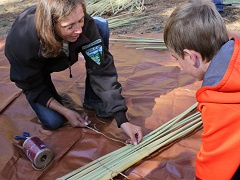
Participants Will Learn About the Past in Archaeology Day event
The Bureau of Land Management, Forest Service and Susanville Indian Rancheria will offer a hands-on look into the lives of northeast California’s early inhabitants during Archaeology Day, a free, family friendly event, from 10 a.m. to 2 p.m., Saturday, Oct. 5, at the Hobo Camp Day Use Area along the Susan River just west of Susanville.
Participants can try using an atlatl to throw a spear, learn how to use a compass, learn about petroglyphs and create their own rock art. A hands-on exhibit will allow participants to simulate an archaeological study, and a biologist will share information about native plants and animals. Gold Rush-era games and tule mat weaving round out the glimpse into the history and pre-history of the northeast California region. (BLM press release)
|
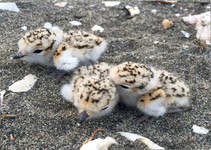
Snowy Plovers Returning to Restored Babitat at Humboldt Bay South Spit
For nearly two decades, Bureau of Land Management staff in Arcata have been grooming beach habitat to encourage nesting by western snowy plovers, small shorebirds that are listed as a threatened species. For much of that time, BLM staffers were disappointed when the birds ignored the new nesting areas.
That all began to change in 2016, when increasing numbers of fluffy, spotted plover chicks began appearing on the restored habitat beaches of the Mike Thompson Wildlife Area, South Spit, Humboldt Bay. The staffers were thrilled at the end of this year’s recording setting nesting season when 37 chicks fledged on BLM’s South Spit habitat. (BLM press release)
|
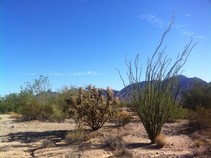
BLM to Restrict Public Access to Bradshaw Trail and nearby Lands During Cleanup
The Bureau of Land Management will temporarily restrict public access to Bradshaw Trail and nearby lands, effective 12:01 a.m., Sept. 16, to 11:59 p.m., Sept. 27, and then 12:01 a.m., Jan. 6, 2020, to 11:59 p.m., Feb. 7, 2020, to ensure the Department of the Navy can safely perform environmental remediation. (BLM news release)
|
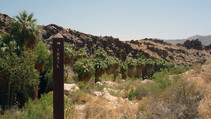
Where to Find California’s Only Native Palm Trees
Maybe it’s because they’re “so L.A.” – one of the surefire signs that we’re in “paradise.” But that’s a myth – one that early European settlers created to draw more people to colonize this “fertile land.”
But most of the palm trees you see are pretenders to the throne – imposters in the world of evergreen palms! (KCET)
|
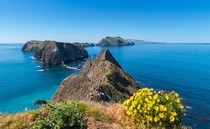
Remote California Natural Wonders Without the Crowds
Do the crowds that descend on Lake Tahoe all summer make you think twice about making the long drive there? How about the traffic queued up on a Friday afternoon in Yosemite Valley? You could walk faster than those trapped SUVs.
With so many of California's best-known natural wonders loved to death, we decided to look for less-traveled alternatives across the state, especially in Northern California. These 11 may not make the state's A-list of scenic spots, but they're certainly worth visiting. (SF Gate)
|

Pheasant Hunts Planned for Women,Juniors at the Bend
The Tehama County Fish and Game Commission recently announced an opportunity for Tehama County apprentice, or junior, hunters and women hunters to enter a drawing to hunt pheasant on the third weekend in November on BLM lands near Bend in Tehama County. (Red Bluff Daily News)
|
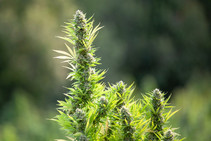
Cannabis Removal on Public Lands Project to reclaim public lands from drug traffickers
A broad-based coalition of conservation organizations, tribes, elected officials, law enforcement agencies, federal land managers, and the legal cannabis industry today announced the formation of the Cannabis Removal on Public Lands Project, an organization dedicated to taking back California’s public lands from drug trafficking organizations. The CROP Project will address the environmental devastation and community safety risk posed by criminal cannabis-growing operations on public lands by cleaning up grow sites and restoring them for public use. (The Willits News)
|

BLM releases Final Environmental Impact Statement for Proposed Ten West Transmission Line Project
The Bureau of Land Management has released the Final Environmental Impact Statement for the proposed Ten West Link Transmission Line project and proposed amendments to the BLM Yuma Field Office Resource Management Plan and California Desert Conservation Area Plan.
The 500-kilovolt transmission line would connect existing substations near Tonopah, Arizona, and Blythe, California. The project, which has been identified as a priority under Title 41 of the Fixing America's Surface Transportation (FAST) Act, would modernize energy infrastructure, strengthen grid reliability and improve efficiency for millions of customers in Arizona and California. (BLM new release)
|

California Campfire Permit
Campfire permits are required for open fires, such as campfire, barbecues and portable stoves on federally managed lands and private lands that are the property of another person. On private lands, written permission from the landowner is also required for campfire use. Get your California Campfire Permit quickly and easily online! (readyforwildfire.org)
Visit the BLM California fire restrictions website for more information about current fire restrictions on BLM-managed public lands.
Follow wildland fire incident information and updates
via InciWeb and CAL FIRE.
|
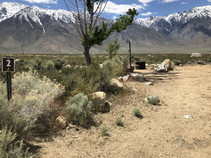
BLM Bishop Field Office Issues Seasonal Fire Restrictions
The Bureau of Land Management Bishop Field Office issued seasonal fire restrictions for BLM-managed public lands in the Eastern Sierra effective Monday, July 1, due to increased wildland fire danger in the region. The restrictions will remain in effect until November 1, or until wildland fire conditions on public lands in the region improve. (BLM news release)
|
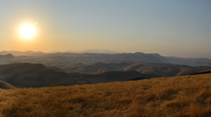
BLM Bakersfield Field Office Increases Fire Restrictions
The Bureau of Land Management Bakersfield Field Office increased fire restrictions for BLM-managed public lands effective Monday, July 1, due to high wildland fire danger. The additional restriction includes no campfires, barbeques, or open fires, regardless if you are in a developed campground, other than portable stoves with gas, jelled petroleum, or pressurized liquid fuel with a valid California campfire permit, available free at all BLM, Forest Service and Cal Fire offices or at www.preventwildfireca.org/Permits. The BLM-managed public lands affected by these fire restrictions are in eastern Fresno, western Kern, Kings, Madera, San Luis Obispo, Santa Barbara, Tulare and Ventura counties; as well as the Carrizo Plain National Monument, Keysville Special Recreation Management Area, Lake Isabella and San Joaquin River Gorge. (BLM news release)
|
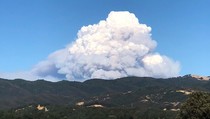
BLM Ukiah Field Office Initiates Seasonal Fire Restrictions
The Bureau of Land Management Ukiah Field Office initiated fire restrictions, effective July 1, for BLM-managed public lands in Colusa, Glenn, Lake, Marin, Mendocino, Napa, Solano, Sonoma and Yolo counties, due to wildland fire danger. (BLM news release)
|

BLM Announces Seasonal Fire Restrictions for Public Lands Managed by Redding Field Office
The Bureau of Land Management implemented fire restrictions for public lands managed by the Redding Field Office in Shasta, Siskiyou, Butte, Trinity and Tehama counties, beginning Monday, July 1. The restrictions will remain in effect until further notice. (BLM news release)
|
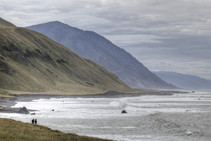
BLM Announces Fire Restrictions for Lands Managed by Arcata Field Office
The Bureau of Land Management implemented fire restrictions for public lands managed by its Arcata Field Office in Del Norte, Humboldt, Trinity, and Mendocino counties, beginning Monday, July 1. The restrictions will remain in effect until further notice. (BLM news release)
|
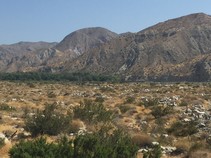
BLM Initiates Whitewater Canyon Closure Due to Increased Wildfire Risk
The Bureau of Land Management is temporarily closing public lands in and near Whitewater Canyon, Riverside County, due to the potential threat of wildfire. This public safety closure started Monday, July 1, and will remain in effect until further notice. (BLM news release)
|
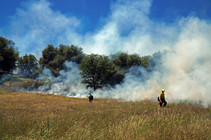
BLM Mother Lode Field Office Initiates Seasonal Fire Restrictions
The Bureau of Land Management Mother Lode Field Office initiated fire restrictions on BLM-managed public lands in Amador, Calaveras, El Dorado, Mariposa, Merced, Nevada, Placer, Sacramento, San Joaquin, Stanislaus, Sutter, Tuolumne and Yuba counties, effective June 14, due to wildland fire danger. (BLM news release)
|
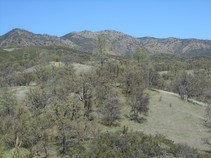
BLM Central Coast Field Office Initiates Seasonal Fire Restrictions
The Bureau of Land Management Central Coast Field Office is initiated fire restrictions, effective June 10, for BLM-managed public lands in Fresno, Monterey, San Benito and Santa Cruz counties, due to wildland fire danger. The National Interagency Fire Center predicts the likelihood for large wildland fires will be above normal this summer. An unusually wet winter has produced an abundant grass crop, which has already cured or dried out. These heavy fuel loads have a high potential for creating extreme wildland fire behavior. (BLM news release)
|
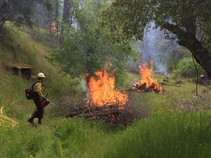
BLM Bakersfield Field Office Issues Fire Restrictions
The Bureau of Land Management Bakersfield Field Office issued fire restrictions for BLM-managed public lands effective May 20, due to potential wildland fire danger. The BLM-managed public lands affected by these fire restrictions are in eastern Fresno, western Kern, Kings, Madera, San Luis Obispo, Santa Barbara, Tulare and Ventura counties. Fire restrictions will also affect BLM-managed recreational areas including the Carrizo Plain National Monument, Chimney Peak, Kennedy Meadows, Keysville, Lake Isabella, San Joaquin River Gorge and Three Rivers. (BLM news release)
|

BLM Initiates Seasonal Fire and Target Shooting Restrictions in the California Desert District
The Bureau of Land Management initiated stage II and III fire restrictions as of April 10 for BLM-managed public lands within Los Angeles, Orange, San Bernardino, Riverside, Imperial, Inyo, Kern, Mono and San Diego counties. These restrictions will remain in effect until further notice. Stage II and III fire restrictions address the use of campfires, controlled flame devices and smoking on public lands. (BLM news release)
|
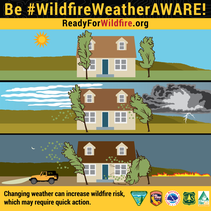
Be #WildfireWeatherAWARE
It’s that time of year again and we need to get ready for wildfire. This includes things like clearing leaves off the roof and out of the gutters, clearing vegetation and combustible materials around your home and preparing or reviewing your evacuation plan. This spring and summer, learn more by following the #WildfireWeatherAWARE campaign with the Bureau of Land Management, CAL FIRE, U.S. National Weather Service, Forest Service and California Fire Safe Council. (BLM California Facebook)
Related: Ready for Wildfire (readyforwildfire.org)
|
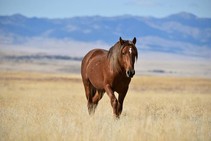
BLM to hold wild horse, Burro Sales Next Week at BH Roundup
The Bureau of Land Management (BLM) will be holding two wild horse and burro adoption events in Belle Fourche next week.
The BLM manages wild horse populations on federal lands as laid out in the Wild and Free-Roaming Horses and Burros Act of 1971 that directed the management, protection, and study of unbranded and unclaimed horses and burros on the country’s public lands.
Under this protection, wild horse populations greatly increased, and although the BLM struggled to implement adequate herd management in many areas, in 1973, it began a successful program for rounding up excess number, and adopting out these captured horses and burros to private owners. This remains the primary method of removing excess horses from managed land, although, in recent years, the adoption rate has not kept up with the removal rate. (Black Hill Pioneer)
|

Secretary Bernhardt Announces Over $100 Million in Public-Private Funding for Wetland Conservation Projects
The Migratory Bird Conservation Commission, chaired by U.S. Secretary of the Interior David Bernhardt, approved $28 million in funding for various wetland conservation projects.
Marking its 30th anniversary since enactment, the 2019 North American Wetlands Conservation Act grants will be used to ensure waterfowl and other birds are protected throughout their life cycles. Of the funds issued, $23.9 million was allocated for the U.S. Fish and Wildlife Service and its partners to conserve or restore more than 150,000 acres of wetland and associated upland habitats for waterfowl, shorebirds and other birds in 20 states throughout the United States. These grants will be matched by more than $72 million in partner funds. (DOI news release)
|
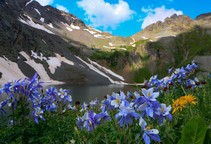
BLM, San Juan National Forest Host Recreation Meetings
The San Juan National Forest and Bureau of Land Management are hosting two public recreation meetings this month, including one about proposed Sage Hen and Rico Trails, and one on regional projects.
The Canyons of the Ancients Visitors Center and Museum offers a photo exhibit and archaeology tours and presentations including a “behind the scenes” curation tour of the museum’s vast archival collection.
From 5 to 7 p.m. Tuesday, Sept. 24, there will be a public meeting at the Dolores Public Lands Office about new recreation trails around Rico and Sage Hen. (The Durango Harold)
|
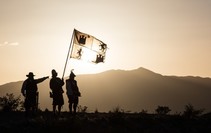
Discover Hispanic Heritage at these Historic Sites
Celebrate Hispanic Heritage Month from September 15 to October 15.
Interior and its bureaus preserve and interpret historic sites across the country. For Americans whose ancestors came from Spain, Mexico, the Caribbean and Central and South America, these places connect them to our nation’s shared history. From early explorers to modern day leaders, Hispanic Americans have influenced America’s culture and played an important role in society. Learn more by clicking through the photos and visiting one of the historic sites near you. (DOI news release)
|
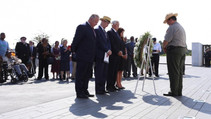
This Week at Interior September 13, 2019
This Week: Remembering the victims of the 9/11 attacks; responding to the landfall of Hurricane Dorian in North Carolina; awarding heroism, accomplishment, and devotion at the 74th Honor Awards Convocation; talking BLM relocation on Capitol Hill; feeling the “prescribed burn” near Trout Springs, Idaho; restoring the sandy seashore in Florida; major grants for Palau, an extension of public lands near Pelican Island, and our social media Picture of the Week! (DOI video)
|

Multiple Choice
What is the maximum length of the Paiute sculpin (Cottus beldingi)?
(a) 1/2 in
(b) 2 in
(c) 5 in
(d) 10 in
Keep scrolling to find out!
|

Volunteers Welcome at National Public Lands Day Projects in King Range NCA
Volunteers are welcome to help the Bureau of Land Management spruce up parts of the King Range National Conservation Area, in upcoming events commemorating National Public Lands Day. Projects will include mountain bike trail maintenance, invasive plant removal and planting native plants. The BLM will provide gloves, tools and materials for all projects.
(BLM news release)
|

September 28 and November 11: BLM Announces Upcoming Fee-Free Days on Public Lands in 2019
The summer travel season gets under way in June with Great Outdoors Month. To encourage visitation to America’s public lands, the Bureau of Land Management will waive recreation-related fees for visitors to agency-managed public lands on three additional dates through the remainder of 2019: September 28 (National Public Lands Day) and November 11 (Veterans Day). BLM-managed public lands offer a wide array of recreational opportunities, including hiking, hunting, fishing, camping, mountain biking, horseback riding, boating, whitewater rafting, off-highway vehicle driving, rock climbing, and more. Americans make approximately 67 million visits annually to BLM-managed lands, supporting approximately 48,000 jobs nationwide and contributing almost $7 billion to the U.S. economy. (BLM news release)
|
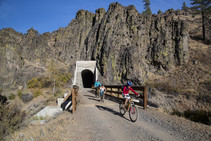
Summer: Bus Shuttle Service to Begin on Bizz Johnson National Recreation Trail
Summer bus shuttle service on the Bizz Johnson National Recreation Trail begins Saturday, June 1, and will continue every Saturday through the summer season. The service is a partnership of the Bureau of Land Management and Lassen Rural Bus. On Saturdays, the bus picks up passengers at 8:30 a.m. at the Historic Susanville Railroad Depot, 601 Richmond Rd., and makes stops at Devil’s Corral, Fredonyer Summit and Westwood. This allows hikers and mountain bike riders to use the trail for return trips to Susanville. Depending on the stop, the return trips are 7, 18 and 30 miles. The BLM shuttles bicycles in a specially-designed trailer. Participants should arrive early to allow time for bike loading. There are separate fees for the bike shuttle and bus service. (BLM news release)
|
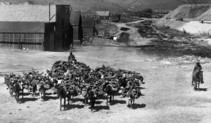
Now - December 2019: Fueling the Boom, Chinese Woodcutters in the Great Basin 1870-1920
The Nevada State Museum in Carson City is hosting a new exhibit featuring historical/ archaeological artifacts and photographs about Chinese woodcutting camps from Bodie Hills. The exhibit will highlight the significance of the woodcutting community near Chinese Camp (Aurora), shedding light on the little-known history of the Chinese woodcutters who lived there and felled pinyon pines to supply charcoal and firewood to the mining camps of Bodie and Aurora from 1875 to 1915. (Nevada State Museum website)
|
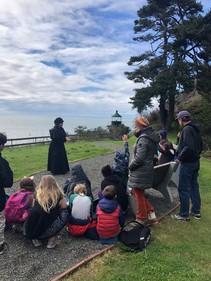
First Saturday of Every Month: Living History at Trinidad Head Lighthouse
BLM Park Ranger Julie Clark plays Josephine Harrington for Trinidad School students at Trinidad Head Lighthouse. Josephine lived with her husband, Captain Fred Harrington the lighthouse keeper, at the Trinidad Head Lighthouse for 28 years. Julie has been performing this living history piece to bring the past to life since the BLM acquired the lighthouse in 2014. Now part of the California Coastal National Monument, the Trinidad Head Lighthouse is open to the public the first Saturday of every month (year-round). Visitors can climb to the top of the lighthouse from 10 a.m. to 12 p.m. thanks to docents from the Trinidad Museum Society.
Contact the Arcata Field Office for details, (707) 825-2300.
|
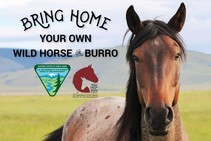
Ongoing: Bring Home a Wild Horse or Burro
The BLM Wild Horse and Burro Program is excited to announce nearly 70 events this year as part of BLM's efforts to find good homes for our nation's wild horses and burros. Known for their intelligence, endurance and loyalty, wild horses and burros, with the right training, are outstanding for trail riding, packing, working and have successfully competed for awards in numerous fields from endurance riding to dressage. With more than 81,000 wild horses and burros on BLM-managed public lands, these wild icons of our American history need your help more than ever. Without any natural predators that can control population growth, wild horse and burro herds grow rapidly on the range and can quickly overcome the land's ability to support them. The BLM works to maintain healthy wild herds by gathering excess animals and placing them into good homes. (BLM website)
Related: Adoption Incentive Program (BLM website)
|

Your Public Lands in California
Public lands in the Golden State offer a sense of adventure for the outdoor enthusiast, offering rivers, trails, campgrounds, off-road open areas and more. The experiences are as varied as the landscapes.
Spectacular scenery can be found among scenic vistas, such as the foggy bluffs of the King Range National Conservation Area, in the ancient redwood forest of the Headwaters Forest Reserve, in the geological formations of the Alabama Hills, the valley of golden flowers in the Carrizo Plain National Monument and the wind sculpted sand dunes in the Imperial Sand Dunes Recreation Area.
You will also find wilderness areas, national scenic and historic trails, national wild and scenic rivers, wildlife viewing areas, off-road opportunities and even a lighthouse or two to explore and learn about California's history. Your BLM adventure starts here! (BLM California Facebook video)
Be sure to follow #MyPublicLands on social media!
Also, follow along as we highlight opportunities for #BLMAdventures
on your public lands across the nation.
|
|
WILDLIFE QUESTION OF THE WEEK ANSWER
the answer is (c). The maximum length of the Paiute sculpin is 5 inches.
Paiute sculpins favor living on rubble or gravel in cold, moderate-gradient streams where water temperatures rarely exceed 20°C. They are also found living in lakes and surviving sustained temperatures in the range of 20-25°C where water flow is ample. Because Paiute sculpins typically live in the riffles of clear streams they are often found in association with trout. In Lake Tahoe Paiute sculpin are most often found in deep water near aquatic macrophytes. In both stream and lake environments the sculpins feed primarily at night when they can more easily ambush and capture prey. Their diet in a stream may consist of aquatic insect larvae, aquatic beetles, snails, water mites, or algae. Dragonfly larvae are a focal point of feeding in meadow streams. Feeding in Lake Tahoe varies with the depth of the sculpin. Deep water dwellers feed on mostly detritus and algae, with other prey items supplementing their diet. Paiute sculpins in shallower regions eat primarily benthic organisms such as chironomid midge larvae.
The feeding habits of Paiute sculpins vary with body size and seasonal changes, as certain prey are more available during specific time periods. They feed year-round with decreased consumption rates in fall and winter. (UC Davis)
Related: Backyard Habitat for Wildlife (U.S. Fish & Wildlife Service brochure)
|
|
|
News.Bytes is a publication of the Bureau of Land Management in California.
Bureau of Land Management
California State Office
2800 Cottage Way, Suite W1623
Sacramento, CA 95825
(916) 978-4600
Send comments to the News.Bytes Team | Subscribe to News.Bytes | Unsubscribe
|
     
|
|
|